Dungeon Crawl Classics Adventure Modules by gradenko_2000
Idylls of the Rat King: Introduction
Original SA post Dungeon Crawl Classics, a game that used a simplified version of D&D 3rd Edition mechanics (no Trip rules, for example) and married it with character generation that prevented optimization via random rolls and a "survival of the fittest" level zero campaign start. It also drew heavily on more "old-school" fantasy tropes, where the adventurers only ever went down dungeons, the monsters were weird and varied, and corridors were laden with traps.[a link to Capfalcon's partial F&F review of the DCC system]
What some people might not know is that Dungeon Crawl Classics was also the name of a series of adventure modules that Goodman Games has been publishing since 2003, back in the heady days of 3rd Edition and the d20 boom. The ethos of these modules were:
quote:
Remember the golden days of role playing, when adventures were underground, NPCs were there to be killed, and the finale of every dungeon was the dragon on the 20th level? Well, those days are back. Dungeon Crawl Classics feature bloody combat, intriguing dungeons, and no NPCs who aren’t meant to be killed. Each adventure is 100% good, solid dungeon crawl, with the monsters you know, the traps you fear, and the secret doors you know must be there somewhere.
Goodman Games released more than 50 of these modules for 3rd Edition from 2003 to 2008, and then when D&D 4th Edition was released, was one of the first publishers to make third-party content for that edition under the new GSL. They made about 15 modules for 4th Edition from 2008 to 2011. Now, I don't know how well they did under the GSL, but the year after that, the company effectively pulled a Paizo as far as developing Dungeon Crawl Classics as its own separate game whose licensing rights they had full control over, on top of having game mechanics that more closely fit their way of developing modules.
I will be reviewing the very first Dungeon Crawl Classics module, titled Idylls of the Rat King, written by Jeffrey Quinn back in 2003.
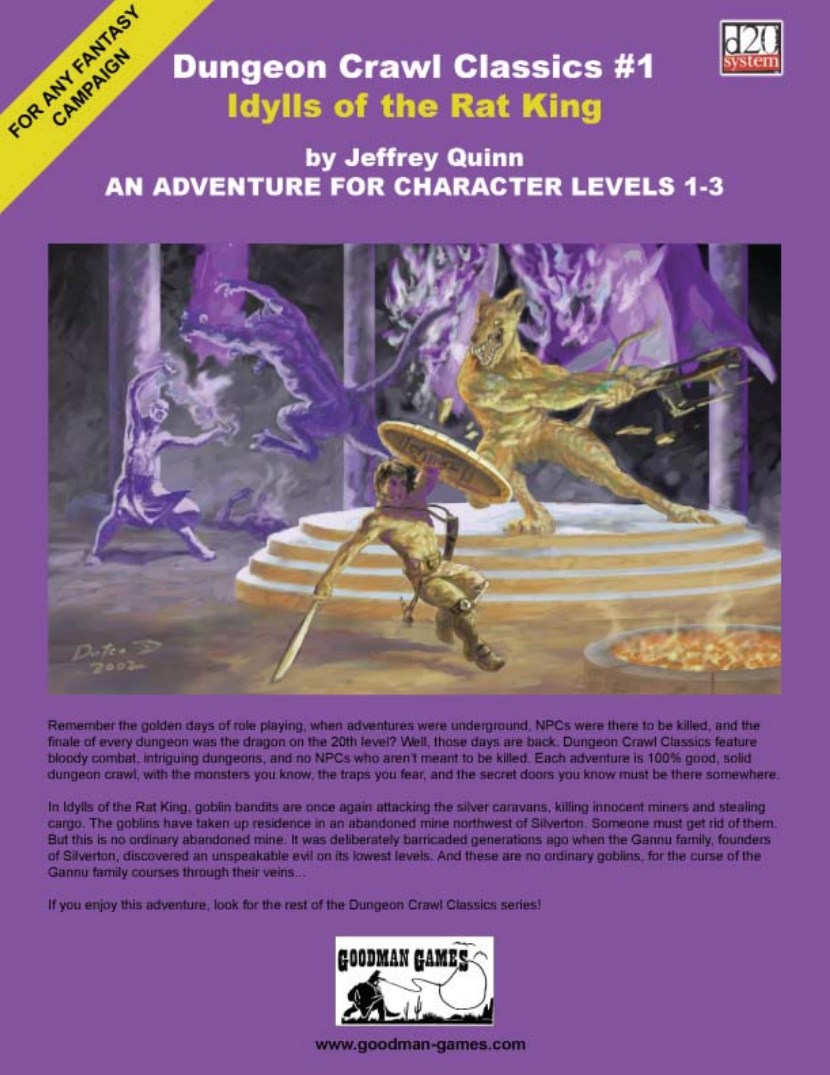
The cover art is by Jeff Doten. It does look like a very deliberate callback to TSR module covers.
The book starts off with old-school, square blueprint maps (is there a specific term for this kind of thing?)
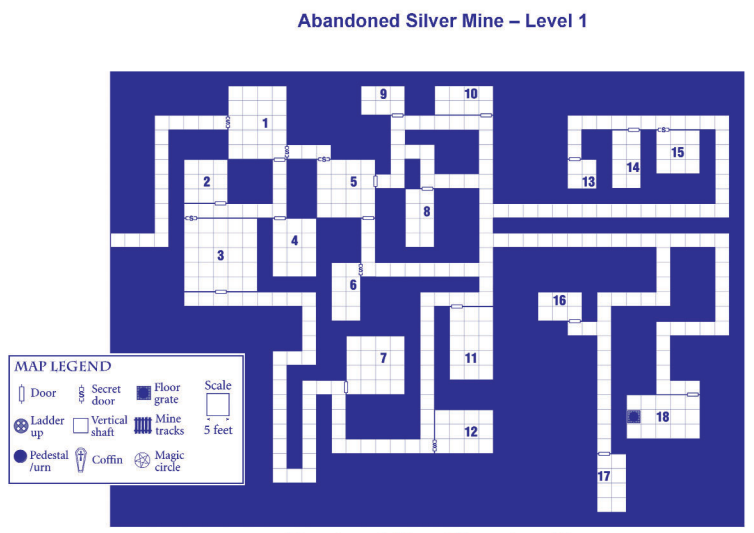
and then has a plot synopsis and a reference table for the map location, composition, page number and Encounter Level for every encounter in the book.
There's a Scaling Information section to tell you how to change the game to accommodate either fewer characters, or more/higher-level characters, usually by eliminating or adding more encounters, or reducing/increasing the number or level of monsters in each encounter.
The intended party is four to six characters of levels 1 to 3. The book outright recommends the need for a Rogue and a Good-aligned Cleric. There's also a strong suggestion for "At least one strong fighter with a silvered weapon" as "helpful, but not necessary". I'm not sure how you'd manage to swing inserting that kind of specific character build into your game without spoilers; maybe if you were importing a level 2 or 3 character that just finished a different module, but it's first book in a series that starts at level 1, and that practically implies you're going in with newly-created characters.
Then there is a Getting the Players Involved section, with three plot hooks to get the players diegetically involved. They are variations on a theme:
* A merchant staying at the inn of the town of Silverton will hire the players to slay goblins that have been known to be operating out of an abandoned silver mine north of town, for they have been attacking silver caravans passing through the region.
* A young noble will stumble through the door of the town midwife. He is heavily wounded, and will tell his story of how his caravan was attacked by goblins and left him for dead. He'll say the goblins left thataway, and the midwife will pitch in about how she knows that that direction leads to an abandoned silver mine. The noble will beg the players to investigate and avenge him and his comrades before passing out.
* As the players enter the town, they are immediately met by the leader of the Miner's Guild. He'll say that his workers have been assaulted and his operations sabotaged by goblins, and he suspects that they're operating out of a silver mine north of town that had been abandoned many years ago. He agrees to reward the players if they get rid of the threat.
Very straightforward, but then that's to be expected with the tone of the game.
There is also a section on Player Death, which informs the GM of what to do with the players in the event of a unconsciousness and death. Players that are knocked out but not killed end up in a prison section of the dungeon, and players that flee can either get direct healing from the midwife, or rest at the town's inn. Players that are outright killed are still completely lost from a gameplay perspective, but the book does tell you what their fate will be.
What then follows is a one page background story of the events that lead up to Silverton, along with a For the GM's Eyes Only quarter-page that lets the GM know what's really going on.
But I will save that for later. What I want out of this F&F is to go through the module as a semi-omniscient player, and see what we can find out in that manner.
As a player, the beginning we get is:
quote:
Through the dense underbrush and tangled trees you have followed the beaten trail of the goblins that have been plaguing the town of Silverton. Before you is the open mouth of the abandoned Gannu family silver mine. The time has come to be heroes
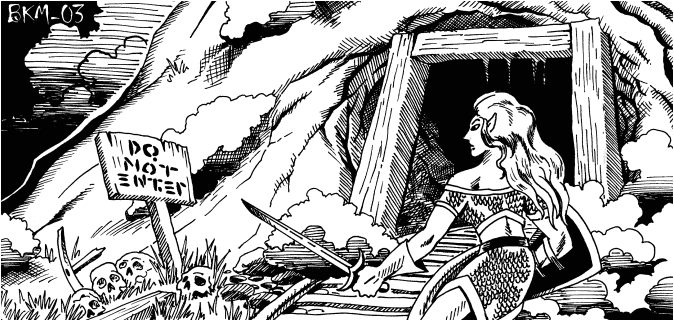
Internal art is credited to Brad McDevitt
Up next: Abandoned Silver Mine, Level 1: The Goblin Lair
Idylls of the Rat King: Part 2
Original SA post Dungeon Crawl Classics #1 - Idylls of the Rat King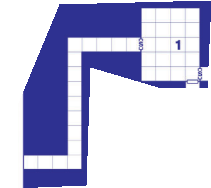
With the players entering the dungeon from the bottom left edge, you'll notice that the entrance to the very first room of the dungeon is keyed with a Secret Door:
quote:
Before you are the collapsed remnants of the tunnel you have been following. Small footprints can be seen entering the wreckage, as if it weren’t there. There must be a secret door!
Props to the game telling the GM to tell the players that there has to be a secret door, or else it'd be a pretty short adventure. It's a DC 13 Search/Spot check to find a hidden latch to make the debris rise mechanically. If the players don't/can't make the check, then they have to dig through the wreckage, which causes so much noise that the four goblins inside Room 1 will summon reinforcements from the adjoining rooms.
Because this is 3rd Edition, every door is statted out with its thickness, hardness, HP, Break DC when Stuck, and Break DC when locked. The walls are also statted out with hardness, HP, Break DC (of 65!) and Climb DC.
Once you clear out the four (or more) goblin guards (they're easy mooks with 1, 1, 2, and 8 HP respectively), it's a DC 15 Search/Spot check to detect the secret door on the bottom right, but let's assume for now that our intrepid adventurers go through the normal door at the bottom:
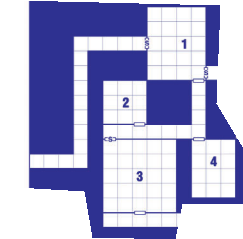
They'll first end up in Room 4, which is an abandoned dining room/kitchen. If the players get the bright idea to try and eat the leftovers, it's a DC 13 Fort save to avoid getting Goblin Food Poisoning:
quote:
Goblin Food Poisoning: Type: Ingested, DC 13; Initial Damage: 1 Con; Secondary Damage: 1d2 Con; Price: –.
Proceeding down the corridor would lead them to Room 2, which is the "Outer Barracks" with tables, chairs, bedrolls, and a pile of soiled laundry in the middle of the room. A Listen check will reveal a rustling sound coming from the laundry. If the players investigate it, they're attacked by two Dire Rats that were living in the garbage under the clothes.
At this point, I'd also note that there is a section on Wandering Monsters. You're supposed to keep track of time, because there is a 15% chance every 30 minutes that the party will be attacked by a random encounter (a 1d6 table of goblins, rats and zombies). The 15% chance is supposed to increase if the party is actively making noise and/or are yelling, breaking objects, or are otherwise causing a ruckus.
Personally, I'm really not sure how you're supposed to do this in a practical sense. I mean, I get that 3rd Edition has rules for how long it takes to walk down corridors and perform a Search check, or that breaking down the door to Room 1 can be done by Taking 20 on the Strength check to break it, and that takes 2 minutes, but it's so fiddly and book-keepy and rules-referency that I can barely imagine anyone doing it that way.
Anyway, after investigating Room 2, they have a chance of spotting the Secret Door leading to Room 3 with a DC 14 Search or Spot check. They sort of have to, since the adventure would dead-end at this point for not having any other place to go. I guess you're supposed to roll those checks until you pass, and keep track of how much time is consumed as it contributes to the Wandering Monster counter. A consolation is that the DC seems to be low enough to be routinely passable even by a level 1 character with 4 ranks in Spot that uses Take 10 on it.
Room 3 is the Main Barracks, and the party will have to fight the seven goblins inside. The game does give the GM leeway to let the players obtain surprise, such as if they managed to enter Room 1 via the secret mechanism and entered this room through the secret door. The game also has a Tactics section for most encounters with intelligent actors, although in both this and in Room 1 the goblins are said to fight to the death, since they're more afraid of their masters than of the players.
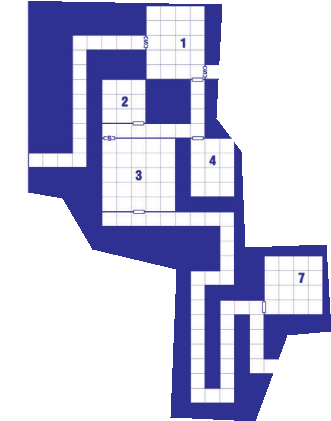
After clearing out Room 3, there's a winding series of corridors leading up to Room 7, which is the Inner Barracks, with bunk beds and foot lockers. There are no enemies here, but the players can score a whole 10 GP if they succeed in a DC 21 Search check.
(All these rooms have their own read-to-the-players flavorful description text, though I'm not reproducing all of them here)
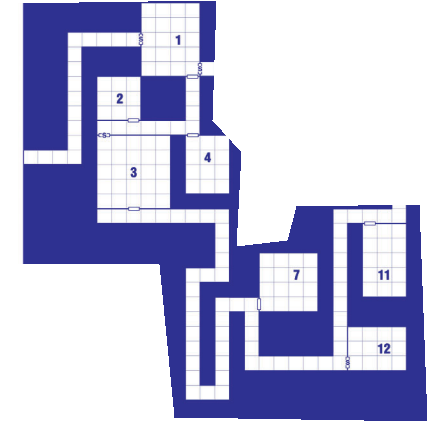
Room 12 is a secret, and the door to it can only be detected with a DC 20 Search/Spot check. When you open the door, you also get the first trap of the game: a CR2 Portcullis trap that will make a d20+10 attack roll against the first person through the door and will deal 3d6 damage on a hit. It's a DC 20 Search to detect, a DC 20 Disable Device to disarm, and if it gets triggered, the portcullis will block the way into the room and it's a DC 28 Break check to get through it.
If you get through all that, you'll a missing/stolen silver shipment: three crates of silver ore worth 1500 GP each, except they weigh 600 pounds each, so it's supposed to be a significant task to bring it out of the dungeon. Hope you're tracking the time for those Wandering Monster checks!
Room 11 is another dining room. DC 17 Spot checks or DC 15 Listen checks will reveal two Dire Rats munching on the rancid and rotten leftovers. They'll attack the party if they get too close to the food, but will flee if they're reduced to half HP or less.
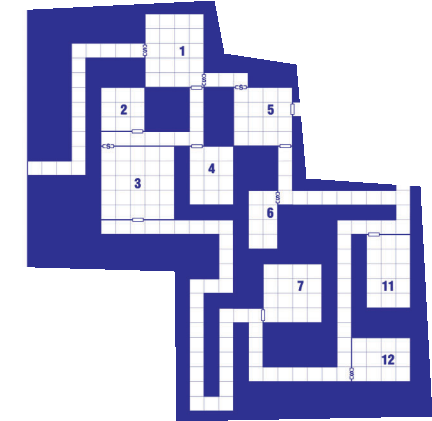
If the party decides to double-back by going north, they have a shot at Room 6, which is yet another secret door. The game notes that:
quote:
a character must be actively looking for secret doors or an elf must pass within 10 feet of the door. In either case, a Search or Spot skill check is required (DC 18)
That first part with the Elf is a call-back to earlier versions of D&D when detecting secrets was a racial ability of Elves,
Anyway, the door is actually trapped: DC 22 to detect a Poison Needle Trap, and a DC 20 Disable Device to disarm it. If the party gets past this, they'll find a single wooden chest in the middle of room. It's only a DC 15 Open Lock check to open the chest, but it's actually empty. The real treasure requires a DC 18 Search/Spot check to notice a loose stone slab elsewhere in the room that can be moved aside to reveal a +1 Silvered Longsword. That sort of red herring thing is in keeping with the old-school dungeon crawl mindset.
We also get our first hand-out here, as the sword includes a note from its former owner:
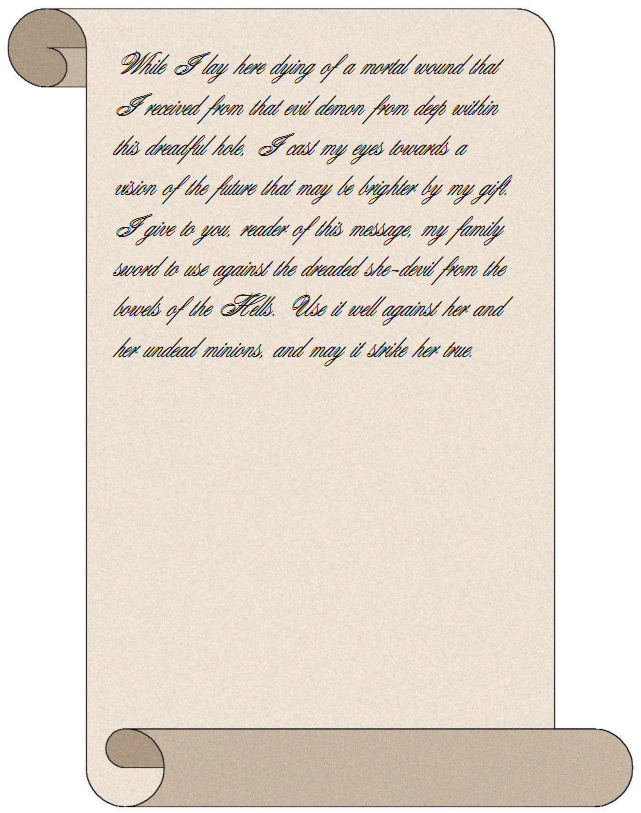
This is quite transparently a way to let the players access to a silvered weapon if they didn't already have one, but it seems somewhat unlikely that they'd pass all the checks and cues necessary to get there unless the players are very familiar with the necessary playstyle.
Room 5 is an Inner Guard Post that could have been entered from Room 1 if the players made their Search/Spot checks, but otherwise approaching it from the normal door will reveal four more goblins. The Tactics section tells the GM to have the Goblins use their crossbows and concentrate their ranged fire on spellcasters, before switching to short swords and melee on round 2.
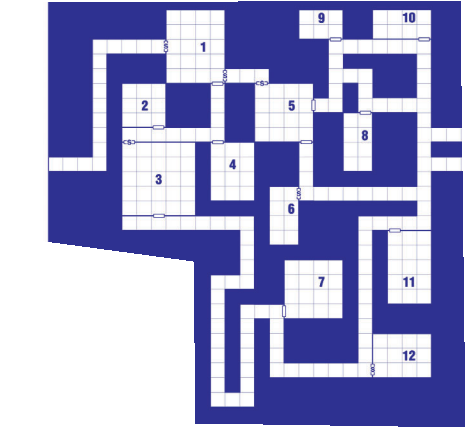
Moving east from Room 5 or north from Room 11, Room 8 is an empty room that's dressed up for a conference/meeting, but a DC 24 Search check will reveal a note hidden inside that brings us to our second hand-out:
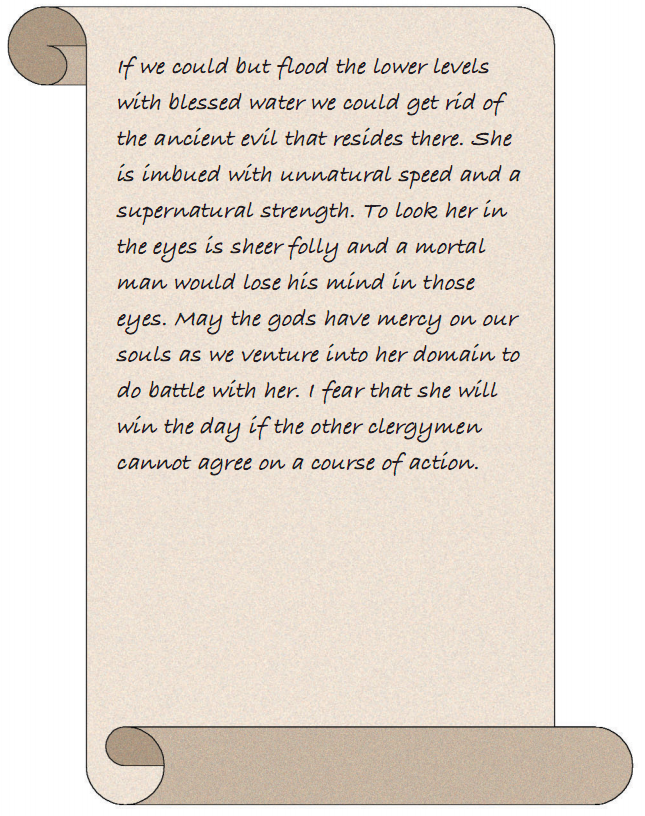
This is our second reference to some kind of feminine evil that resides deeper in the mine, as well as clues to the players on what powers she has and what needs to be done to stop her.
Room 9 is locked - DC 25 Open Lock check to get through. If they get through, the players will find that it's an armory, with multiple crates full of weapons. If the players make a DC 20 Search check or better, they can find a Masterwork weapon. If it's DC 16 to 19, it's just a normal weapon. Anything less and it's crude and rusted. The game doesn't specify how many checks they can make, so I assume they can keep searching as long as they're willing to eat the time investment.
Room 10 is the Lair of the Rats:
quote:
A strange, magical darkness covers the interior of this room. The only sound escaping from the impenetrable darkness is a soft squeaking noise. As if noticing the open door, the squeaking gets louder and closer to the door!
This is where all of the rats reside, and the room is under a permanent Darkness spell (and the GM gets told of how that happened). The five Dire Rats will attack anyone entering the room, but they themselves will take the -4 penalty for fighting in darkness.
That's about half of the first floor so far. While all of the enemies that have been faced so far have never had more than 8 HP, this seems like a lot to deal with a party that doesn't have much more than 6-10 HP themselves, along with that one trap in Room 12 that's almost guaranteed to kill anyone that trips it.
Monster Count so far:
15 Goblins (CR 1/4)
9 Dire Rats (CR 1/3)
Up next: Abandoned Silver Mine, Level 1: The Goblin Lair, Part 2